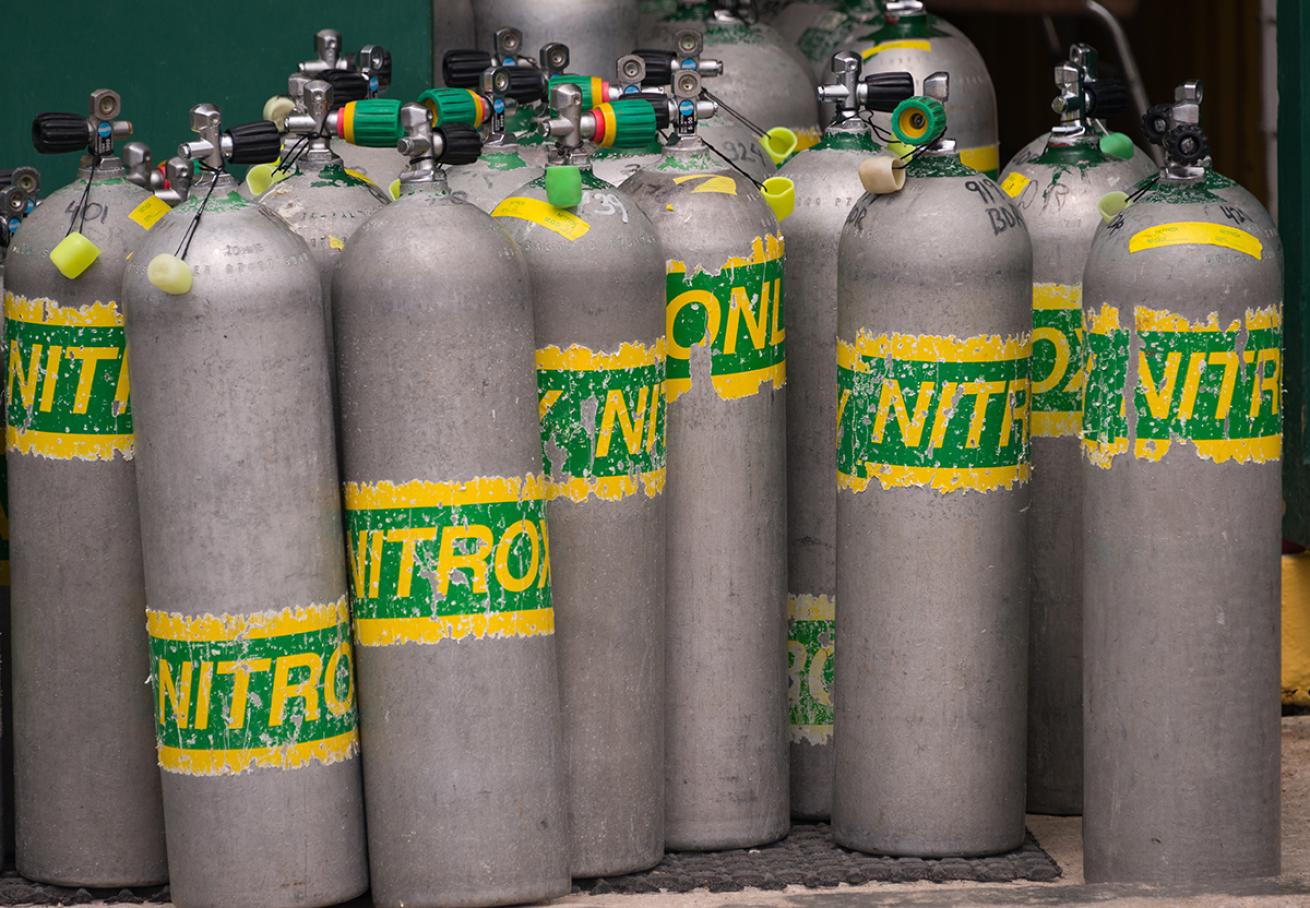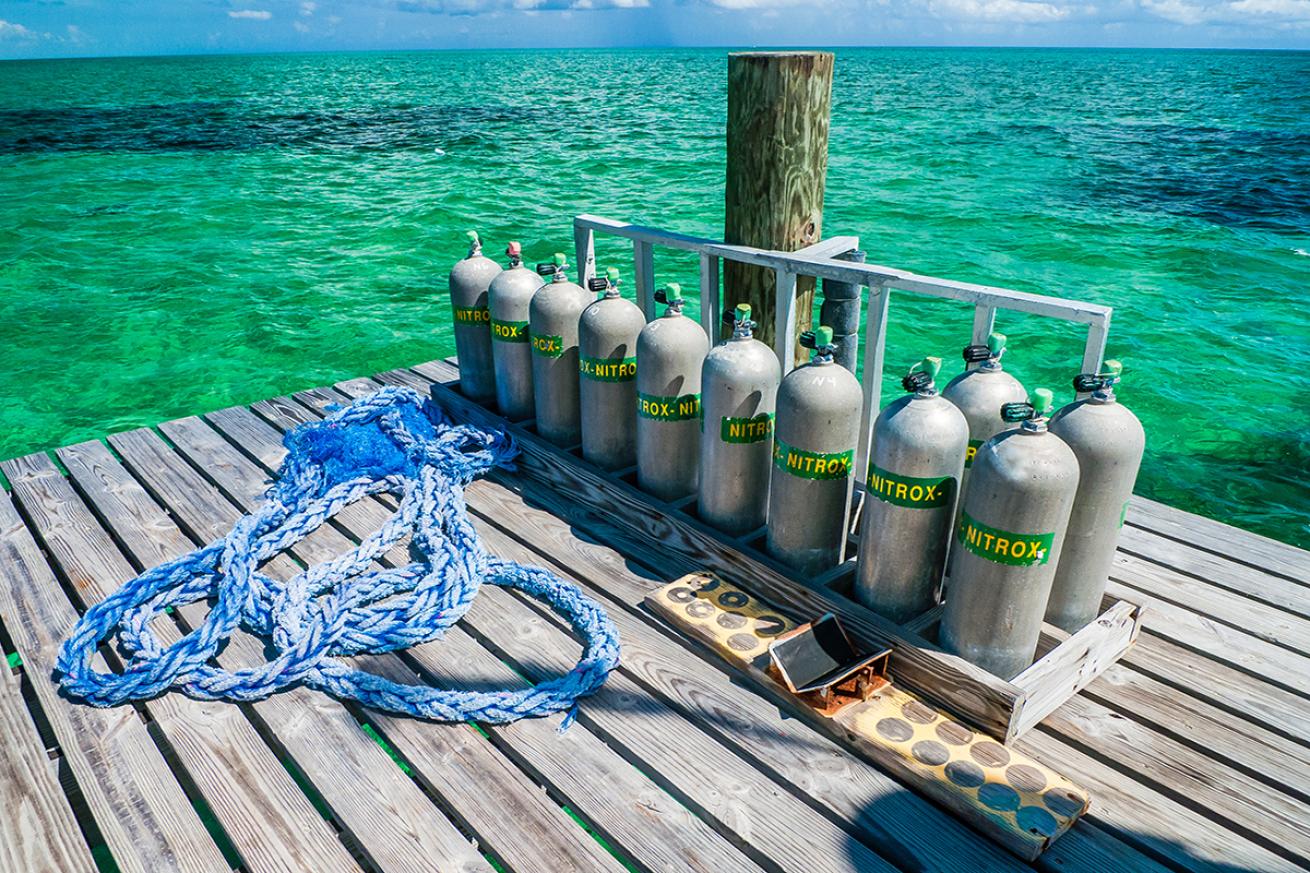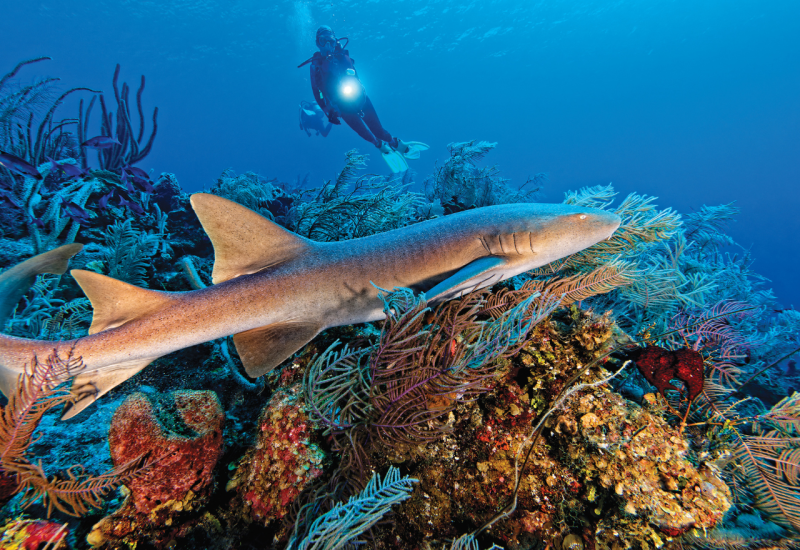Guide to Nitrox Diving

Shutterstock.com/TimsImages.UKOxygen content in enriched air canisters can be customized, but most shops offer standard mixes.
On today's dive boats, you're hard-pressed not to see one or two of the telltale green and yellow tanks that signal somebody aboard is scuba diving with nitrox, also called enriched air, oxygen-enriched air, EAN, EANx or just "nitrox" for short. It’s been used in recreational diving for decades, and every major training agency has a training program for scuba diving with enriched air.
Like everything else in a diver's bag of gear and knowledge—nitrox is a tool that can be effective when used properly, but dangerous if not. Its purpose is to increase your no stop dive time, so you have longer dives and/or shorter surface intervals, all else being equal and gas supply allowing. But, it has shallower depth limits and other concerns you don't have with air within recreational diving limits.
What is Nitrox?
In recreational diving terms, enriched air nitrox (EANx) refers to any nitrogen/oxygen gas mixture with more than the 21 percent oxygen found in normal air. For example, 32 percent and 36 percent oxygen are common; you'll hear them called nitrox 32 (or 36) or EAN32 (or 36). To clearly identify them from air cylinders, tanks filled with EAN are marked with a yellow and green tank band at the top, just below the crown. The oxygen mix percentage is written on a label or tag, which is important because the percentage affects your depth limits and no stop dive time.
How Does EAN Nitrox Work?
Enriched air has more oxygen than air does, which reduces the percentage of nitrogen. As a result, you inhale less nitrogen throughout the dive than if you’re using regular air.
We all learned in our Open Water Diver course that, when you dive, the water pressure causes nitrogen from the air you're breathing to dissolve in your bloodstream and tissues. The higher the pressure (deeper the dive) and the more time under pressure (bottom time), the more nitrogen dissolves in. If you surface with too much dissolved nitrogen in your tissues, bubbles can form causing decompression sickness (DCS). Staying within the no stop limits limits the theoretical amount of dissolved nitrogen so that you can ascend directly to the surface (but make your safety stop). If you exceed this limit (as do tec and commercial divers), you have to make mandatory decompression stops in stages as you come up to keep the risk of DCS low. Based on the Recreational Dive Planner, for example, a diver on air at 100 feet reaches his or her no-decompression after 20 minutes. At 60 feet, the diver's maximum time would be 55 minutes. But, nitrox changes these numbers.
Because you're breathing less nitrogen, less dissolves into your body, all else being equal, allowing a longer no-decompression limit. This can be calculated using an equivalent air depth (EAD), which is a shallower depth at which nitrogen would be going into solution at the same rate if you were using air. If, for example, at 105 feet with EANx32 has an EAD of 90 feet, so you're absorbing nitrogen as if you were 15 feet shallower. Therefore, the diver's ordinary no-decompression limit of 15 minutes extends to 25 minutes—that's a 66 percent increase in bottom time.

Shutterstock.com/troutnutNitrox is one of the most popular continuing education scuba skills.
Advantages of Diving with Nitrox
The best application of nitrox is in the 50- to 100-foot range. No stop times for dives shallower than 50 feet are often so long that you'll empty your tank before you run out of dive time. Using EANx36 at 60 feet, your no stop limit is 80-90 or more minutes (depending on your computer) for your first dive, so you'll again be limited by your gas supply, not your decompression limit.
You were taught to dive well within limits, and by pushing the limits outward, you can dive longer and still be conservative. Many enjoy nitrox diving to or even beyond air limits without being anywhere near the actual no stop max. As with air this doesn't guarantee 100 percent safety, but staying well within limits reduces practical DCS risk for most divers.
Interested in diving nitrox? Start your adventure here with PADI's Enriched Air Diver course.
Dangers of Diving with Nitrox
This benefit does not come without some cost. Oxygen, while useful and essential to life, can become hazardous in high concentrations. Too much oxygen at pressure affects the central nervous system–oxygen toxicity–causing convulsions or seizures, visual distortions, ringing ears, nausea, twitching, irritability and dizziness, with convulsions or seizures being the most serious while diving.
Oxygen toxicity hits are very rare in diving, but if they happen under water, they happen without warning and lead to drowning if you lose the regulator while convulsing. Any percentage of oxygen can cause toxicity if you go deep enough, but with air you have to go well beyond established depth limits for this to be likely. With nitrox, the depth limit is within recreational diving depths, and the more oxygen, the shallower the limit–the limit is the depth at which the PPO2 would be 1.4 ata. Long term exposure to elevated oxygen can cause a different type of oxygen exposure as well. Earning a nitrox certification is required because, among other issues, EANx divers must learn now to manage their oxygen exposure.
Calculating your PPO2
When enriched air first came into recreational diving, there were no EANx dive computers and few tables. So, you figured out everything with a pencil and calculator.
If you have mathphobia, hold on! NO ONE does this any more in recreational nitrox diving. You look up the maximum depth on a table (easy), set your computer with the EANx mix you're using (easy) and it calculates your oxygen exposure and adjusted no stop time. In fact, diving EANx with a computer on a multilevel profile, you'll almost always end the dive due to low gas, cold, hungry or gotta pee. You need to learn how to analyze your mix (not difficult) and some equipment considerations, but these are all covered in the PADI Enriched Air Diver course.
You do, however, need to understand what your computer is doing for you so you can use that information accurately and safely.
For example, the pressure component of the oxygen limit is calculated using partial pressures. You can find it by multiplying the oxygen percentage of the EANx by the absolute pressure (in atmospheres or bar). For example, a diver breathing air (21 percent O2) at 132 feet (5 ata) is breathing a partial pressure of oxygen (PPO2) of 1.05. This would be equivalent to breathing 105 percent oxygen at the surface. In other words, you can't breathe that PPO2 at the surface even using pure oxygen.
- If you're interested, calculating that PPO2 looks like this: 5 ata x 0.21 percent O2 = 1.05 PPO2
- Finding the surface equivalent percent is easy – drop the decimal
- The depth limit is based on the depth at which a mix would have a PPO2 of 1.4, so this is calculated: Max Depth = *(1.4 ÷ mix%) - 1) X 33
- The mix percent is entered as a decimal (e.g. 32% use .32)
Note: Technical divers will often dive to a partial pressure of oxygen up to 1.6 PPO2 but they're trained in further associate risk management.
What Nitrox Won't Do
Enriched air is sometimes talked about like it’s a cure-all for every diving downside. That’s not the case, so let’s take a moment to bust a few myths.
Myth 1 - Using it means you're less likely to get narced.
This sounds reasonable. If nitrogen causes narcosis and you're breathing less of it, you should have less narcosis. The trouble is, the depth range where you start worrying about narcosis (100 to 130 feet) is also where you have to stop using nitrox because of the risk of oxygen toxicity. And even if it weren't, oxygen is thought to be about as narcotic as nitrogen (not always but usually — gets complex), so you're one step up and one step back anyway. The preventive value of nitrox is "very small, so marginal that I think it should be discounted” writes Dr. Peter Bennett in the chapter on inert gas narcosis in The Physiology and Medicine of Diving.
Myth 2 - It reduces your gas consumption.
This sounds reasonable too. If there's more oxygen in each breath, presumably you don't have to take another one so soon and your gas consumption rate is lower. Unfortunately, it doesn't work that way because most of the oxygen you breathe is exhaled unused anyway. What drives the next breath is the need to exhale carbon dioxide, and that's not affected by what's in your tank.
Myth 3 - Nitrox allows you to dive with less fatigue.
The theory here is that the work of offgassing nitrogen is a major cause of diving fatigue, so less of it should leave you less tired. Many nitrox divers swear it's true, but Bennett cites a blinded study that proved otherwise. Using unmarked tanks, one group of divers was given nitrox, another was given air, and both were asked later how they felt. "There was no difference," says Bennett. "It's a placebo effect."
Myth 4 - You can dive deeper with enriched air.
Some divers think those green-and-yellow cylinders look serious and "techie," and associate that with going deep. As you just learned, EANx introduces a shallower depth floor and the penalty for going below it – potentially dying – is serious, too. Many of us would risk chasing that eagle ray down to 150 feet on a normal air mix, but wouldn't think of it on nitrox. But, tec divers use EANx for decompressing in the shallows after a deep dive, which may be one reason some think it is a deep diving gas.
Getting the Right Nitrox Mix
The pre-mixes offered at most dive shops—usually 32 or 36 percent—make life simple. Just pick up the tank, analyze the mix, confirm the maximum depth and enter it into your computer.
But you can use other blends. Ask, and your dive shop will most likely blend a tank with whatever percentage you need for your dive, as long as it's below the recreational limit of 40 percent. Custom mixes like this really do give you the best bang for the buck. For example, using EANx32 at 70 feet has an EAD of 56 feet (a table NDL of 55 minutes) but using EANx40 it's 45 feet (table limit 100 minutes), giving you more dive for your dollar. In places where a given mix is particularly useful due to depth, dive centers commonly stock that EANx blend.
Nitrox and Recreational Equipment Safety
The U.S. Navy and the National Oceanic and Atmospheric Administration (NOAA) say standard scuba equipment can be used for oxygen concentrations up to 40 percent. Since this is also the maximum recreational limit for nitrox diving, there has never been gear-related incident recreational diving equipment used within recreational nitrox limits. (Note: Some manufacturers use a more conservative rule. Always follow a manufacturer's recommendations for their gear.)
Contrary to popular belief, oxygen does not burn.It does, however, enhance the flammability of everything that it contacts—the higher the concentration of oxygen,most substances ignite more easily, and burn hotter and more rapidly. For this reason, there is one equipment exception and that is the scuba tank, for two main reasons.
One reason is that a common method of making nitrox (especially custom mixes) requires putting pure oxygen in the tank first followed by specially filtered oxygen compatible air second. Because the tank contains pure oxygen during blending, they must meet oxygen service standards, which means the materials (o-rings, valve seats) and any lubricants must be rated for use with pure oxygen. The tank must also be specially cleaned, which is done annually.
The second reason, as you learned, is that the tank must be clearly marked so it is not accidentally dived as air. The distinctive EANx band is at the top of the cylinder so it is visible, even when surrounded by a cluster of cylinders.
Earn a Nitrox Diving Certification
PADI’s Enriched Air Diver course includes eLearning that can be completed in a few short hours. In person learning, is done in a day or two, gives you the chance to analyze a tank, set your dive computer for nitrox, and fill out an enriched air log with a PADI pro there to guide you.
Nitrox Formulas and Definitions
- Normoxic nitrox: Regular air, or cleaned air with 21 percent oxygen
- EAN, EANx, enriched air, enriched air nitrox: Any mix with more than 21 percent oxygen
- EAD: Equivalent Air Depth. The relationship between nitrogen absorbed at a particular depth breathing nitrox and the depth at which an equivalent absorption rate would occur breathing air.
- PPO2 (or PO2): Oxygen partial pressure, pressure in atmospheres x O2 percentage = PPO2
- MOD or maximum depth: Max depth = *(1.4 ÷ mix%) - 1) X 33
- Best Mix: 1.4 ÷ ((Depth + 33) ÷ 33) = best mix










